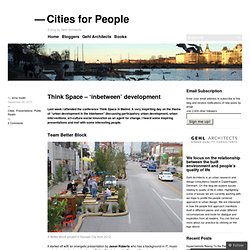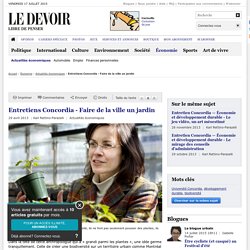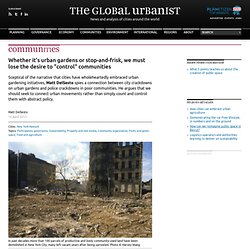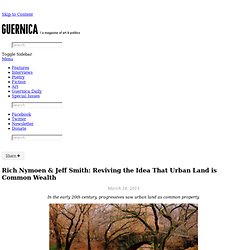

Stranger Studies 101: Cities as Interaction Machines - Kio Stark. Editor's Note: Nothing has challenged our notions about what it means to "know" or "meet" someone more than the various ways we interact online.

With geolocation services like Foursquare and augmented reality applications on the horizon, what it means to be a stranger or a friend is only getting more complex. We asked Kio Stark, a professor at New York University's Interactive Telecommunications Program to share her syllabus on Stranger Studies here. The students at ITP spend two years learning how to make and break all kinds of technology, and as Stark puts it, her classes "are about shaping a deeper, more rigorous understanding of the people my students are making things for. " Volume 2.
Think Space – ‘inbetween’ development. Last week I attended the conference Think Space in Malmö.

A very inspiriting day on the theme of “urban development in the inbetween” discussing participatory urban development, urban interventions, art-culture-social innovation as an agent for change. I heard some inspiring presentations and met with some interesting people. Team Better Block A Better Block project in Kansas City from 2012 It started off with an energetic presentation by Jason Roberts who has a background in IT, music and arts and is the founder of team Better Block (based in Texas, US) and who works with artists and local communities on re-imagining and activating underused blocks and spaces.
Raumlabor_Berlin Another keynote was given on “Direct urbanism – the powers of ephemeral acts in public” by Markus Bader from Raumlabor_Berlin. The Kitchen Monument by Raumlabor is a mobile sculpture which has two states of being.
Villes en transition. Entretiens Concordia - Faire de la ville un jardin. Dans la tête de cette anthropologue qui a « grandi parmi les plantes », une idée germe tranquillement.

Celle de créer une biodiversité sur un territoire urbain comme Montréal grâce à l’implication et aux talents de jardiniers de ses citoyens. De retour d’un voyage au Royaume-Uni, Katja Neves est désormais convaincue que son idée a ce qu’il faut pour prendre racine. « Nous devons arrêter de voir uniquement la conservation d’une biodiversité comme étant la préservation d’une forêt vierge, explique la professeure au Département de sociologie et d’anthropologie de l’Université Concordia. Nous avons l’opportunité de conserver et de produire des biodiversités ici même dans les villes. »
Whether it's urban gardens or stop-and-frisk, we must lose the desire to "control" communities. Sceptical of the narrative that cities have wholeheartedly embraced urban gardening initiatives, Matt DelSesto spies a connection between city crackdowns on urban gardens and police crackdowns in poor communities.

He argues that we should seek to connect urban movements rather than simply count and control them with abstract policy. As the spring season gets underway here in New York, tens of thousands of gardeners from more than 700 farms and gardens across the city are making preparations for the coming growing season. Most urbanists these days are not surprised to hear of such an active urban agriculture movement in a large metropolitan area such as this. In reality there is much that should surprise and inspire us. The existence of a burgeoning urban environmental movement is anything but inevitable.
Rich Nymoen & Jeff Smith: Reviving the Idea That Urban Land is Common Wealth. In the early 20th century, progressives saw urban land as common property.

Image from Flickr via VinOnD40 By Rich Nymoen and Jeff SmithBy arrangement with On the Commons During the Progressive Era that ended with World War I, there was a popular economic imperative to make land common property, especially with regard to urbanized land. This meant not that land should be nationalized or occupied communally. Instead the concept was similar to the one applied when an estate is left in common to its inheritors, which often leads to them renting out the property and splitting the proceeds equally among themselves.
In the Progressive Era view, humanity inherited the earth “in common” so its land should—for both moral and economic reasons—be “rented out” to those holding title to it, with society collecting the rent in the form of a tax equal to the land tract’s annual rental value. Currently, the only way one can profit from land is to develop it or sell it. Crowdfunding a City-Spanning Pedestrian Bridge [Video] Demonstrating the scale of what's possible via crowdsourcing, one city in the Netherlands built a city-spanning pedestrian bridge, funded, plank by plank, by the crowd.
![Crowdfunding a City-Spanning Pedestrian Bridge [Video]](http://cdn.pearltrees.com/s/pic/th/crowdfunding-pedestrian-75507364)
The brainchild of Rotterdam-based design firm Zones Urbaines Sensibles, the bridge connects different parts of town, it increases the city’s walkability, it encourages interaction and it is revitalizing struggling areas. Thrivability: A Collaborative Sketch. Ville + Numérique.
Ville + Numérique. The Power of the Everyday. Essay: On the smart city; Or, a 'manifesto' for smart citizens instead. On the smart city; A call for smart citizens instead Big data + social media = urban sustainability?

The promise of smart sustainable cities is predicated on the dynamics of social media alloyed to the Big Data generated by an urban infrastructure strewn with sensors. Feedback loops are supposed to engage citizens and enable behaviour change, just as real-time control systems tune infrastructure to become more energy efficient. Social media dynamics enable both self-organisation and efficient ecosystems, and reduce the need for traditional governance, and its associated costs.
Yet is there a tension between the emergent urbanism of social media and the centralising tendencies of urban control systems? And in terms of engaging citizens, we can certainly see evidence of increased interest in using social media for urban activism, from crowdfunding platforms to Occupy Everywhere and the Arab Spring. Efficiency as cul-de-sac But the city is something else. The city is its people.